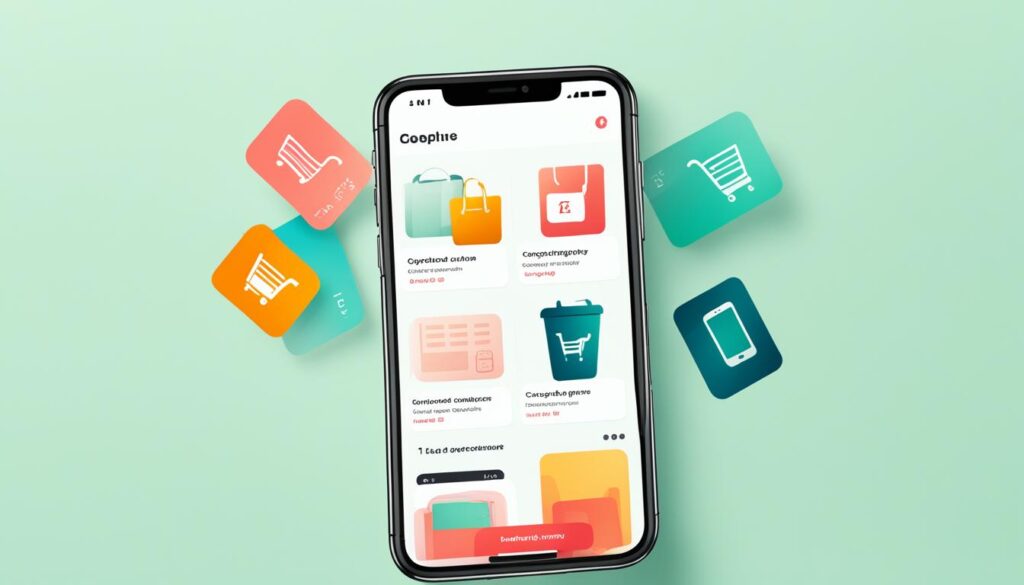Saving money doesn’t have to be a daunting task. In fact, there are plenty of small things you can do that will have a big impact on your finances. From automating transfers to reducing your gas usage, these tips will help you save time and money while boosting your efficiency and overall financial well-being.
Do you believe that saving money requires major sacrifices? What if we told you that there are simple and practical tips that can help you boost your efficiency, save time, and save money? These small changes can have a significant impact on your financial well-being.
Key Takeaways:
- Automate transfers from your checking account to your savings account to effortlessly save money
- Counting your coins and bills can lead to slow-and-steady savings growth
- Preparation and meal planning can help you save money on groceries
- Reducing restaurant spending and using credit card rewards can keep more money in your pocket
- Take advantage of free events, discounted tickets, and loyalty programs to save on entertainment
Automate transfers
One of the easiest ways to save money is by automating transfers from your checking account to your savings account. This simple technique allows your savings to accumulate over time without any additional effort on your part. By setting up automatic transfers, you can ensure that a portion of your income goes directly into your savings account, helping you reach your financial goals faster.
There are various apps available that can assist you in automating these transfers, making the process even more convenient. Two popular options are Digit and Qapital. These apps can analyze your spending habits and identify how much you can afford to save. They will then transfer small amounts from your checking account to your savings account on a regular basis.
Automating your transfers not only simplifies the saving process, but it also helps you stay consistent and disciplined towards your savings goals. Rather than relying on manual transfers, which can be easily forgotten or postponed, automation ensures that you are consistently putting money aside.
This method is particularly beneficial for individuals who have specific savings goals in mind, such as purchasing a house, going on a dream vacation, or building an emergency fund. By automating transfers, you can gradually but steadily work towards achieving these financial milestones.
Benefits of Automating Transfers:
- Consistent savings growth: By automating transfers, you can ensure that your savings grow consistently over time, without the need for constant monitoring and manual deposits.
- Effortless saving: With automated transfers, you don’t have to remember to save or take the time to transfer money manually. The process is done for you, making saving effortless.
- Goal-oriented approach: Automating transfers aligns with your financial goals and keeps you focused on achieving them. You can set specific savings targets and track your progress towards them.
- Financial peace of mind: Having automated transfers in place can provide a sense of security and peace of mind, knowing that you are actively working towards your financial stability and future.
Whether you choose to use banking features or dedicated savings apps, automating your transfers is a smart and practical way to build your savings account. By effortlessly setting money aside, you can make steady progress towards your financial goals and enjoy the peace of mind that comes with knowing you’re proactively securing your financial future.
Count your coins and bills
Saving your spare change by setting it aside each night can add up over time. Once you have a significant amount, you can deposit it directly into your savings account, allowing your funds to grow even more. This method is especially effective for those who prefer using physical money, as it can be harder to part with than swiping a card. While it may not provide immediate results, this approach promotes slow-and-steady savings growth.
If you’re someone who often receives physical money as change from purchases, this is a great opportunity to save that change and watch it accumulate. By simply adding any loose coins and stray bills into a designated jar or piggy bank, you’ll be surprised at how quickly they can add up.
Benefits of saving change and physical money
The act of physically handling money can have a different psychological impact than using digital or card-based transactions. Seeing and physically setting aside your coins and bills reinforces the idea of saving and creates a tangible representation of your progress. It can also serve as a visual reminder of your financial goals, motivating you to continue saving.
Additionally, depositing your saved change into your savings account allows those funds to generate interest over time. This slow-and-steady growth can provide a sense of satisfaction and contribute to your overall financial well-being.

Tips for saving change and physical money
- Create a designated jar or container specifically for saving your spare change.
- Make it a habit to empty your pockets or wallet at the end of each day and add any change into the jar.
- Consider keeping small bills as well, as they can also contribute to your savings.
- Set a savings goal for your spare change, whether it’s a certain amount or a specific date by which you want to deposit it into your savings account.
- Use this method as a way to instill the value of saving in children by involving them in the process and encouraging them to add their own change to the jar.
Remember, while saving change and physical money may seem like a small endeavor, every penny adds up over time. By incorporating this simple habit into your routine, you can take advantage of slow-and-steady savings growth and watch your funds grow.
Prep for grocery shopping
A little preparation before going to the grocery store can save you a substantial amount of money. By integrating meal planning, creating a grocery list, utilizing coupons, and making use of cash-back credit cards, you can maximize your savings and avoid unnecessary spending. Additionally, many grocery stores offer loyalty programs that provide additional discounts in exchange for your contact information.
Meal Planning
One effective strategy to save time and money is through meal planning. By creating a weekly or monthly meal plan based on the ingredients you already have, your schedule, and sale items at the store, you can avoid impulse purchases and reduce food waste. Plan meals that utilize similar ingredients to further optimize your grocery list.
Grocery List
Creating a comprehensive grocery list is crucial for staying on track and avoiding unnecessary purchases. Before heading to the store, review your meal plan and write down all the ingredients you need. Organize your list by categories such as produce, dairy, meat, and pantry items. Having a structured list will help you navigate the store efficiently and resist the temptation to buy items not on your list.
Coupons
Take advantage of coupons to save even more money on your grocery shopping. Check online coupon websites or manufacturer websites for printable coupons. You can also find digital coupons through grocery store apps or loyalty programs. Clip or save the coupons for items on your grocery list to make the most of your savings.
Cash-Back Credit Cards
Consider using cash-back credit cards when paying for your groceries. These cards offer a percentage of cash back on your purchases, allowing you to earn rewards while buying essential items. Look for credit cards that offer higher cash-back rates for grocery purchases or rotating categories that include groceries. Be sure to pay off your balance in full each month to avoid accumulating interest charges.
By incorporating meal planning, creating a grocery list, using coupons, and taking advantage of cash-back credit cards, you can make your grocery shopping trips more cost-effective. Not only will you save money, but you’ll also stay organized and avoid unnecessary purchases. Take advantage of loyalty programs, which may offer additional discounts or rewards, to further enhance your savings.

Minimize restaurant spending
Eating out at restaurants can be a delightful experience, but it often comes with a hefty price tag. To save money and maintain a healthy budget, it’s important to reduce the frequency of dining out and opt for cooking meals at home. By making this small change, you can significantly cut down your expenses and have greater control over your finances.
When you do choose to indulge in a restaurant meal, there are a few strategies you can employ to minimize your spending. Consider sharing an entree with your dining partner or sticking to appetizers, which are often cheaper than main courses. This not only helps reduce portion sizes but also lowers the overall cost of the meal.
Additionally, take advantage of credit card rewards that offer benefits for restaurant spending. Many credit card companies provide cash-back rewards or points that can be redeemed for various perks or discounts. By using a credit card that rewards you for dining out, you can actually save more money in the long run.

Comparing Credit Card Rewards for Restaurant Spending
| Credit Card | Reward |
|---|---|
| Chase Sapphire Preferred | 2x points per $1 spent on dining |
| Capital One Savor | 4% cash back on dining |
| Discover it Cash Back | 5% cash back on rotating categories, including restaurants |
| American Express Gold Card | 4x points per $1 spent at restaurants worldwide |
The table above highlights some popular credit cards and their rewards for restaurant spending. Make sure to research and choose a credit card that aligns with your spending habits and offers the most beneficial rewards for you.
By being mindful of your restaurant spending, reducing its frequency, and harnessing the power of credit card rewards, you can enjoy dining out while still saving money and staying on track with your financial goals.
Get discounts on entertainment
Entertainment expenses can quickly add up, but there are ways to save money in this area. Take advantage of free events at museums and national parks, as well as local community events. These events offer a chance to enjoy cultural experiences without spending a dime. Whether it’s an art exhibition or a concert in the park, free events provide a budget-friendly way to have fun.
In addition to free events, many venues offer discounted tickets for various groups. Students, seniors, military members, and more can often enjoy reduced admission prices to museums, theaters, and attractions. These discounts can make a significant difference in your entertainment budget, allowing you to experience more while paying less.
You can also look into loyalty programs offered by entertainment venues and organizations. These programs provide additional savings and perks to frequent visitors. For example, some theaters offer loyalty programs that give members access to discounted tickets, exclusive screenings, and concession discounts. By signing up for these programs, you can save even more on your entertainment expenses.
| Benefits of Getting Discounts on Entertainment | How to Get Discounts |
|---|---|
| 1. Save money | 1. Attend free events |
| 2. Experience more within your budget | 2. Take advantage of discounted tickets for various groups |
| 3. Access additional perks through loyalty programs | 3. Sign up for entertainment venue loyalty programs |

By utilizing these strategies, you can enjoy the entertainment you love while keeping your budget in check. Whether it’s attending free events, taking advantage of discounted tickets, or signing up for loyalty programs, there are plenty of opportunities to save money on entertainment. So go out, have fun, and make the most of your entertainment budget!
Map out major purchases
When it comes to making major purchases, timing is everything. By strategically planning your buying decisions, you can take advantage of annual sale periods and price drops, ultimately saving a significant amount of money.
One of the key strategies is to wait for annual sale periods when retailers offer discounts on a wide range of products. Whether it’s Black Friday, Cyber Monday, or seasonal sales, these events provide an opportunity to grab your desired items at lower prices.
In addition to timing your purchases, it’s crucial to track prices over time. Price tracking tools, such as browser extensions and mobile apps, can be valuable allies in helping you monitor price fluctuations. These tools can alert you to price drops or notify you when the product you’re interested in reaches your desired price point.
For online shopping, browser extensions like Honey or CamelCamelCamel can automatically track prices and notify you of any changes. This allows you to confidently make a purchase when the price is at its lowest.
If you prefer shopping in person, there are apps like ShopSavvy that can help you compare prices across different stores. By scanning barcodes or searching for specific products, you can quickly find the best deal in your area.
Mapping out your major purchases and utilizing price tracking tools can ensure that you’re getting the best deal possible. With careful timing and monitoring, you can save a substantial amount of money while still acquiring the products you need.
Restrict online shopping
Online shopping can be convenient and exciting, but it can also lead to unnecessary impulse purchases and overspending. To maintain control over your finances, it’s important to implement strategies that encourage responsible online shopping habits. By avoiding impulse purchases and deleting shopping apps, you can make thoughtful decisions about your purchases and ensure that you are spending money wisely.
Manually Enter Billing Information
To avoid impulse purchases, it’s crucial to create obstacles that give you time to consider each online purchase. One effective tactic is to avoid saving your billing information on websites. Instead, opt to manually enter your credit card details each time you make a purchase.
By requiring yourself to enter this information manually, you create a deliberate pause during the checkout process. This extra step forces you to consciously evaluate whether the purchase is truly necessary, allowing you to avoid impulsive decisions.
For instance, imagine coming across an enticing offer while browsing online. Instead of clicking to complete the purchase with just a few taps or clicks, forcing yourself to manually enter the billing information gives you the time needed to ponder whether it aligns with your financial goals and priorities. This deliberate act of reconsideration helps curb impulsive spending and encourages conscious decision-making.
By taking this simple step, you can regain control over your online shopping habits and develop more thoughtful purchasing patterns.
Delete Shopping Apps
In today’s digital age, shopping apps have become increasingly popular, offering convenience at our fingertips. However, these apps can also fuel impulse buying tendencies.
To minimize the temptation to shop online, consider deleting shopping apps from your phone. By removing these apps, you reduce the frequency of exposure to promotional notifications and enticing offers that might lure you into making impulsive purchases.
Deleting shopping apps can help break the habit of mindlessly browsing and making unnecessary purchases. Instead of aimlessly scrolling through shopping app catalogs, you can use that time for more mindful activities, such as reading a book, pursuing a hobby, or spending quality time with loved ones.
Ultimately, deleting shopping apps helps create a healthy distance between you and the constant influence of online shopping. It’s a proactive step towards regaining control over your spending habits and aligning your purchases with your financial goals.
Remember, avoiding impulse purchases and deleting shopping apps are essential components of responsible online shopping. By taking these measures, you can develop a more intentional approach to your online purchases, ensuring that every item you buy aligns with your needs and overall financial well-being.

Delay purchases with the 30-day rule
One effective strategy to prevent overspending is to implement the 30-day rule. This rule involves giving yourself a cooling-off period between when you first desire an item and when you actually make the purchase. By introducing this delay, you can avoid impulse buys and make more thoughtful decisions about your online shopping.
When you come across an item you want to buy while browsing online, resist the temptation to make an instant purchase. Instead, add the item to your cart and wait for 30 days before proceeding with the transaction. During this cooling-off period, take the time to consider alternatives, evaluate your budget, and determine if the item is a true necessity or a fleeting desire.
This waiting period allows you to step back from the immediate gratification of online shopping and gives you an opportunity to reassess your decision. It helps you avoid impulse buying and potential regret over overspending on items you don’t genuinely need or value.
For smaller purchases, consider implementing shorter delay periods such as 24 or 48 hours. This approach still provides the necessary break to evaluate your purchase, but accommodates the lower cost and urgency of these items.
This is how the 30-day rule can benefit you:
- It helps you consider alternatives: During the cooling-off period, you can explore other options for fulfilling your needs or desires. This could involve researching different brands, comparing prices, or seeking out similar items with more affordable price tags.
- It prevents impulse purchases: Taking a step back and waiting before making a purchase can help you avoid impulsive buying. It allows the initial excitement to fade, helping you make a more rational decision based on your needs and priorities.
- It helps you prioritize your spending: By introducing a delay, you can prioritize your spending and allocate your money to items or experiences that truly matter to you. It helps ensure that you’re not wasting your hard-earned money on fleeting trends or unnecessary items.
- It encourages mindful consumption: The 30-day rule promotes conscious and mindful consumption, as it encourages you to pause and reflect on your purchases. It helps you develop a habit of considering the long-term value and utility of the items you buy, rather than succumbing to impulse and instant gratification.
By practicing the 30-day rule, you can avoid overspending, make more intentional purchases, and achieve greater financial satisfaction. So the next time you find yourself adding items to your online cart, remember to take a step back, give yourself a cooling-off period, and consider whether it’s a purchase that aligns with your priorities and budget.

Conclusion
Implementing these 19 small things that save time and money can have a significant impact on your overall financial well-being. By automating transfers, minimizing restaurant spending, and tracking your expenses, you can develop efficient money habits that will help you achieve your savings goals.
Remember, even small changes can make a big difference when it comes to saving money. By being mindful of your spending and making smart financial choices, you can improve your financial well-being and work towards a more secure future.
So start today and take control of your finances. Set your savings goals, practice efficient money habits, and watch as your financial well-being begins to flourish.










